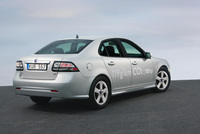Saab 9-3 diesels set 119 g/km CO2 class benchmark

Class-leading CO2 emissions of 119 g/km are on offer within the latest Saab 9-3 range, which benefits from an across-the-board emissions reduction of 10 percent, making this car a perfect choice for company car users, and a cost-effective option for customers keen to reduce fuel consumption and their carbon footprint.
For Model Year 2011, all 9-3 diesel engines have more advanced twin turbocharged engines and, in the saloon, all three engines give CO2 emissions of just 119 g/km and exceptionally low combined cycle fuel consumption of 62.8 mpg. The most powerful variant, the 180 hp 1.9 TTiD, now delivers the most efficient performance for a four cylinder diesel engine in the marketplace in terms of CO2 per unit of horsepower.
CO2 reduced to 119 g/km
Saab engineers have delivered class-leading diesel performance following an 18-month development program which focused on achieving an average 12 percent reduction in fuel consumption and CO2 emissions. For saloon models, the result is emissions below 120 g/km, a key vehicle taxation threshold in the UK market, and the cleanest and most efficient Saab ever.
By introducing twin turbochargers across the diesel range, Saab engineers have optimised the engines to harness more power and torque in the interests of fuel consumption and lower emissions.
The 1.9-litre diesel line-up now comprises a 130 hp TTiD unit (replacing the previous 120 hp TiD engine), a 160 hp version (replacing the 150 hp TiD engine) and a range-topping 180 hp/400 Nm variant.
With these engines and manual transmission, the 9-3 saloon delivers outstanding combined cycle fuel economy of 62.8 mpg and 119 g/km CO2 emissions, and is tax-exempt for vehicle excise duty. The SportWagon offers an impressive 61.4 mpg and low CO2 emissions of 122g/km and for the Convertible, the respective figures are 54.3 mpg and 137g/km.
To dip under the 120 g/km level, optimised gearing is fitted without affecting acceleration or top speed.
Other efficiency measures introduced include:
Recalibrated engine management with improved fuel injection and combustion control
Revised gear ratios to match new power and torque characteristics
Improved electrical power management, including sophisticated alternator control when battery charging is not required and more efficient electro-hydraulic power steering assistance
Low rolling resistance tires for reduced road friction
Improved aerodynamics, with rear underbody deflector blades
Reduced weight through lighter construction and sound-deadening materials
Revised torque converter for automatic transmission with optimised shift programming.
The all-turbo petrol line-up, which features an average reduction in fuel consumption and CO2 emissions of 7 percent, also benefits from some of these measures.
Standard Equipment Enhanced for MY11
In addition to the significant powertrain improvements, standard equipment levels have been increased for MY11. All 9-3 models now come with Bluetooth phone integration and heated front seats as standard. Other model year enhancements include the introduction of a ‘change-up’ indicator in the instrument cluster to encourage economical driving; a clutch interlock system on manual transmissions; child seat top tether anchorage points and a perforated leather sport steering wheel on Aero models. Two new exterior paint colours have been added to the range – Diamond Silver and Java and rear engine badging has been changed to follow the same style as used on the new 9-5 saloon.

